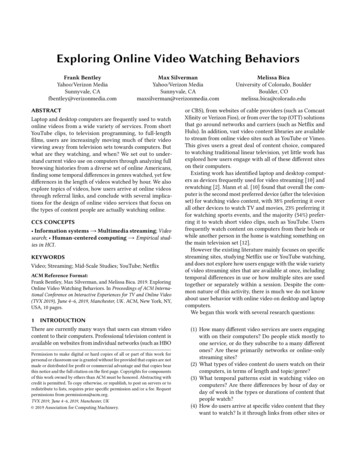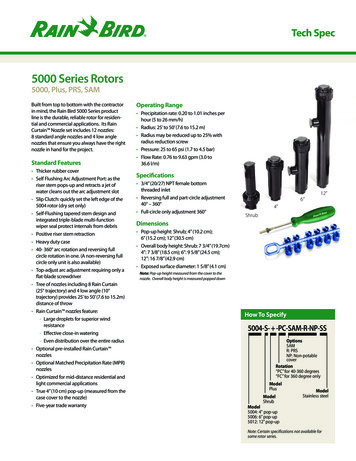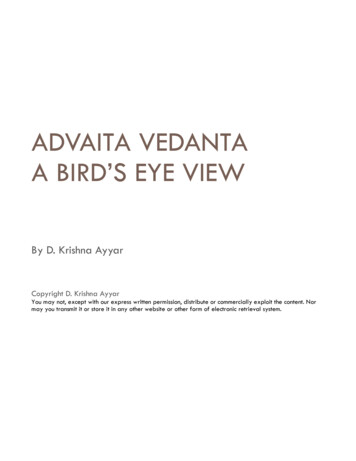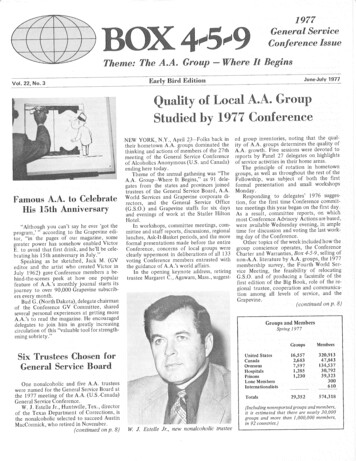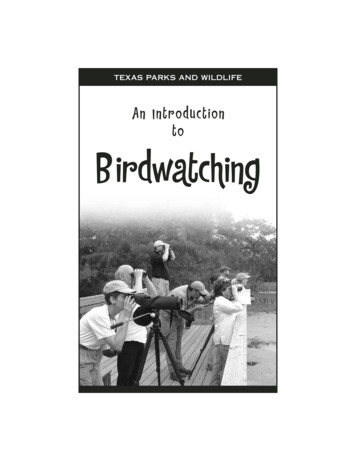
Transcription
TEXAS PARKS AND WILDLIFEAn IntroductiontoBirdwatching
An Introduction to BirdwatchingBirding is probably one ofthe most cosmopolitan out door activities in existence.By all accounts, the ranks ofbirders are growing.Formerly called “birdwatch ers,” birders come from allwalks of life, from doctors tolawyers, teachers, policemen,corporate executives, truckdrivers, merchants, youngchildren, young marrieds and senior citizens. There are as many varieties of bird ers as there are birds. They range from intense perfectionists who travel the globeat the drop of a hat to see a species never seen, to the casual weekend hobbyistwho enjoys watching the neighborhood birds at a backyard feeder or nearbygreenbelt.What is the appeal? Why do so many people enjoy this activity? While eachindividual birder may focus on different aspects of the pastime, I think all willagree, birding fulfills many of our basic criteria for what makes for good outdoorrecreation. Birds appeal to our sense of aesthetics. Birds are beautiful and theirextravagant plumages are dazzling to the eye. Their complex behavior is intrigu ing and their songs are varied, evocative and very pleasing to the ear.Birds occur in a wide variety of places and are abroad both night and day.Birdwatching is something you can do while doing other things, working in thebackyard, tending the garden, walking or jogging in the park, while at work orfrom a kitchen window. Birds can brighten up the day and break the monotonyof a dull routine.More than that, you don’t have to be rich to go birding. All you really need is agood field guide to the birds of North America and a pair of binoculars tostart–some as inexpensive as 30 or 40. (Of course, when you get into fineoptics and spotting scopes, the price can go up substantially). Flying round theworld to New Guinea to get the Raghiana Bird of Paradise on your list will also setyou back substantial sums.Page 1
An Introduction to BirdwatchingBirding always presents an intellectual challenge because there are lots of differ ent species. And Texas is a particularly birdy state. Some birds, due to theircryptic or furtive nature, present great challenges to the birder. Frequently youneed to sort many separate and incomplete clues to come up with the properidentification. The birder doesn’t always get a good long look at the bird.Sometimes much of the bird’s body is hidden behind foliage or it is f lying away.Many times the light is terrible, or the bird continues to disappear from view.Birding generally appeals to our intellectual curiosity: Birds have amazing andvaried behaviors. Some things birds do naturally beg the question why are theydoing this. Anting, pecking at their image in a car mirror or a window, preeningactivities, courtship displays, aggressive displays, hurt-wing displays. You willoften be asking yourself “Why is this bird doing that?”Birding definitely satisfies our sporting instinct: Listing, or as the English call it,“ticking,” is sort of like hunting, but the quarry, a new bird for the list, does notgo into the pot. It is quite a challenge to identify all the birds you see for thereare many species to contend with. But there are also lots of clues. Sound, color,shape, size, place of sighting, behavior cues, time of year, time of day. Being thefirst to properly call a bird can be exhilarating. Identifying a life bird–one youhave never seen–by yourself, can also give you a big boost. Adding species toyour life list can become a great game you can play. It can be competitive amongfriends and birding companions, but more commonly you can just compete withyourself. Not to mention the hand to eye coordination you develop when trainingbinoculars on a moving object. You have to be fast to get on to the bird and toget your binoculars focused correctly. Flying birds, especially those that f ly awayfrom the observer, present special challenges.Birding, as a sport is non-consumptive and nondestructive to the environment. Itresults in no negative impact on the environment, and doesn’t harm the “target”in any way. Spotting and identifying a bird–even misidentifying a bird, doesn’thurt anybody or any thing.A person can bird while walking alone. It is a wonderful way to get away fromthe maddening crowd. But, it is also something you can do very well with therest of the family, with your husband or your children, or with a larger group oflike-minded people.Page 2
An Introduction to BirdwatchingGoing birdwatching is a great way to get out into nature, to keep in touch withthe awe and mystery of the natural world. While you are birding you are alsogetting fresh air, exercise, and learning more about the various areas you visit.Seeing the wildf lowers, trees, shrubs, vines, butterf lies and other critters thatshare the birds’ environment, helps you to appreciate how all the living parts fitinto the whole scheme of things.Tracking the seasonal movements of birds keeps you in touch with the passingseasons. The annual cycle, the mysteries of spring and autumn migration, birdsare pre-eminent harbingers of spring and fall and subtly mark the passage of timeBirding can contribute positively to your feelings of mastery and self esteem.These feelings will increase as you get better at it. While identifying birds is verydifficult in the beginning, as you practice and improve your observation skills andhand-to-eye coordination skills you will start to gain confidence and pride in yournew found ability to take a number of clues and come up with a speedy andcorrect I.D.Finally, amateur birdwatchershave contributed and continueto contribute much to the sci entific knowledge of birds.Their input and personalobservations when backed bynotes, Christmas Counts,Breeding Bird Surveys, etc.help ornithologists and conser vationists learn more aboutbirds and the environment weall share and depend on.Page 3
An Introduction to BirdwatchingHOW TO BECOME A BETTER BIRDERGood birders are not born–they develop their skills progressively with time andpractice. While there are many aids on the market to help beginning birders,such as books, videos, cassettes, CDs, and computer software, there is no substi tute for field experience when it comes to mastering the art of birding. The moretime you spend out in the field, the better you will become.Buy a good field guide to the birds. This is no place to economize. There are sev eral excellent publications on the market that are both portable and complete. Apractical guide will have the picture of the bird, the verbal description, and therange map all on facing pages, so you don’t have to continually f lip back andforth from one part of the book to the next. A Texas birder needs a guide thatcovers bird species occurring throughout the United States. East meets west andnorth meets south in our great centrally located state. The National GeographicSociety’s Field Guide to the Birds of North America is a good one, as are thePeterson Guides and the Golden Guide. Many times these quality guides can alsobe found at your local second hand bookstore.Learn the “topography” of the bird. Most good field guides have a diagram of abird in the beginning of the book with the various body parts identified. Studythe body of the bird diligently. Learn the terms and definitions of the various partsof the body, especially those of the feather tracts. This is how you will communi cate with other birders and understand the descriptions in your field guide. Knowwhich feather groups are visible in various body postures, i.e., when the bird is inf light or perched.Another essential purchase is a good pair of binoculars. These will help bring thebirds closer to you optically so you can better discern a bird’s field marks,plumage pattern and color, as well as subtleties of behavior. While good opticscan be expensive, the choice of brand is very individual. A good guideline is tobuy the best optics you can afford. If you are a beginner, start with a cheapermodel and graduate to a more expensive model as your skills increase.Remember, before purchasing, it’s important to try them out yourself to seewhich size, weight, eye relief, field of view, and light-gathering abilities are bestfor you.Page 4
An Introduction to BirdwatchingBuy yourself a high quality, compact notebook that fits easily in a vest pocket,book pouch, or backpack. Carry it with you at all times in the field, along with awaterproof pen. Keep good field notes, recording interesting observations as theyoccur. Make this a habit. Always record the time of year, time of day, weather con ditions, and place (part of the state with a short description of habitat, vegetationtype and geology if you know it). These notes will be invaluable for future refer ence. Don’t ever try to commit your observations to memory. The mind simplyforgets. Better to take detailed notes on plumage, shape, size, behavior, or anyconfusing observations. Often what you think is an unimportant detail turns outto be the key element to properly identifying a species. Don’t wait to “bird” yourfield guide when you get home at the end of the day. Write down your observa tions carefully first, then check the field guide later. Making your own sketcheswith pertinent comments can also be helpful.Start a personal bird life list. Keep a Texas bird list, as well. You will be amazedhow many birds you can see in the Lone Star State. The Texas Bird RecordsCommittee has recognized 620 species as Texas Birds. Without chasing vagrantsor rarities, you could realistically rack up 450 Texas birds within a reasonableamount of time and effort. The list gets even larger as you bird the entire state atdifferent times of year. And all kinds of lists are possible–yard lists, county lists,foreign country lists, you name it. Then, put your lists on computer if you haveone. There are many excellent software programs available to help organize yourobservations whether you use the Macintosh or IBM PC compatible machines.Become acquainted with the birds of your area. Obtain state checklists, localchecklists, State Park, Wildlife Management Area and National Wildlife Refugebird checklists. Know the seasonal patterns of your area, when the local birdsmigrate and which species you can expect at which time of year (checklists canbe very helpful here). The trick is to reduce the number of possibilities. Dealingwith a possible five species is much easier than trying to cope with all 620.When observing birds feeding in a mixed f lock, see if certain individuals actaggressively towards one another. These interactions can be very subtle, so watchcarefully. Does there appear to be a pecking order among the various species ofbirds? Determine which bird is dominant (titmice dominate chickadees, forinstance). Does age, body size, feather brightness, or sex affect the dominancehierarchy between birds of the same species or even between birds of differentspecies?Page 5
An Introduction to BirdwatchingHOW TO CHOOSE THE BESTBINOCULARS FOR YOUR BUCKSWith all the different brands, styles andprices of binoculars to choose from, it isoften hard to decide which pair is bestfor you. Binoculars can be purchased foras little as 25 to as much as 5,000. Youshould first get a basic understanding ofhow binoculars work so that you can sift through all theseoptions. You will want to end up with a pair that will workbest for your needs and wants, and is the best pair you canafford. In the case of binoculars, price truly does ref lect quality–quality in whatyou will see, and quality in durability. However, you don’t have to drain yoursavings in order to purchase a good pair of binoculars that will satisfy yourpersonal goals.Binoculars come in many different shapes, sizes and weights. The difference inview may be as much as seeing a general silhouette with simple shades of color,to seeing f lecks of differing colors on different parts of the bird’s body. The bestway to decide this, if you aren’t sure, is to try them out before you buy them.Borrowing a pair from a friend or testing them in the store are two ways toaccomplish this task. The dealer may even let you field test them, try them outbefore you buy them.The following are the basics on how binoculars work and how to apply that toyour purchasing decision:1.Binoculars are made up of an objective lens (focuses an upside downimage), a set of prisms (to turn the image right side up again) and an eye piece (to magnify the image). However, each time light enters a pair ofbinoculars and passes through each of these glass pieces, some of it is lost,thus promoting a poorer image. Improved technology has produced specialglass coatings that reduce the loss of light (in some cases restoring as much as95% of the lost light). But as you might have guessed, you will pay more forthese coatings.Page 6
An Introduction to Birdwatching2.Binoculars are described by the magnification power and the size of theobjective lens (10x42, for example). The first number indicates how manytimes closer to you the image is brought, and the second number is the diame ter of the objective lens in millimeters.3.Exit pupils are the beams of light that come out through the eyepieces. It iscalculated by dividing the diameter of the objective lens by the magnificationpower (for example 10x42 binoculars would have an exit pupil of 4.2). Thesize of the exit pupils work with (or against) your own eyes’ pupils. Basically,in low light, larger exit pupils are better because your eyes’ pupils will beenlarged, and visa versa. Decide under which conditions you will be usingyour binoculars most–low or bright light, larger or smaller exit pupils. Also,as we get older, our eyes lose the ability to adapt to lower light more andmore. Therefore, smaller exit pupils will work better for older birders as well.And again, top quality binoculars, with their glass coatings and better optics,will facilitate a brighter picture.4.The field of view is what you will see throug
An Introduction to Birdwatching Page 3 Going birdwatching is a great way to get out into nature, to keep in touch with the awe and mystery of the natural world.

